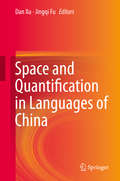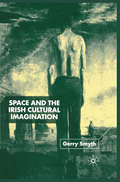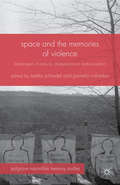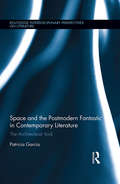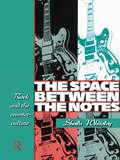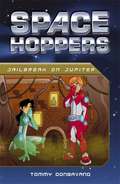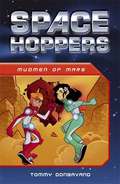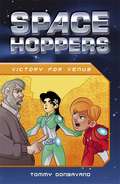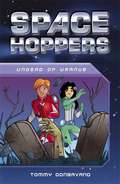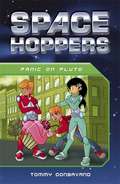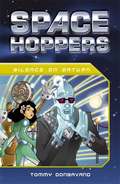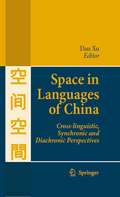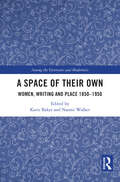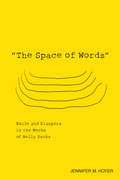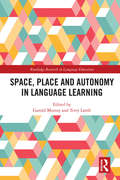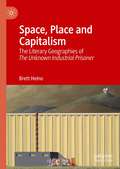- Table View
- List View
The Space and Practice of Reading: A Case Study of Reading and Social Class in Singapore (Routledge Research in Language Education)
by Chin Ee LohMirroring worldwide debates on social class, literacy rates, and social change, this study explores the intersection between reading and social class in Singapore, one of the top scorers on the Programme for International Assessment (PISA) tests, and questions the rhetoric of social change that does not take into account local spaces and practices. This comparative study of reading practices in an elite school and a government school in Singapore draws on practice and spatial perspectives to provide critical insight into how taken-for-granted practices and spaces of reading can be in fact unacknowledged spaces of inequity. Acknowledging the role of social class in shaping reading education is a start to reconfiguring current practices and spaces for more effective and equitable reading practices. This book shows how using localized, contextualized approaches sensitive to the home, school, national and global contexts can lead to more targeted policy and practice transformation in the area of reading instruction and intervention. Chapters in the book include: • Becoming a Reader: Home-School Connections• Singaporean Boys Constructing Global Literate Selves: School-Nation Connections• Levelling the Reading Gap: Socio-Spatial Perspectives The book will be relevant to literacy scholars and educators, library science researchers and sociologists interested in the intersection of class and literacy practices in the 21st century.
The Space and Practice of Reading: A Case Study of Reading and Social Class in Singapore (Routledge Research in Language Education)
by Chin Ee LohMirroring worldwide debates on social class, literacy rates, and social change, this study explores the intersection between reading and social class in Singapore, one of the top scorers on the Programme for International Assessment (PISA) tests, and questions the rhetoric of social change that does not take into account local spaces and practices. This comparative study of reading practices in an elite school and a government school in Singapore draws on practice and spatial perspectives to provide critical insight into how taken-for-granted practices and spaces of reading can be in fact unacknowledged spaces of inequity. Acknowledging the role of social class in shaping reading education is a start to reconfiguring current practices and spaces for more effective and equitable reading practices. This book shows how using localized, contextualized approaches sensitive to the home, school, national and global contexts can lead to more targeted policy and practice transformation in the area of reading instruction and intervention. Chapters in the book include: • Becoming a Reader: Home-School Connections• Singaporean Boys Constructing Global Literate Selves: School-Nation Connections• Levelling the Reading Gap: Socio-Spatial Perspectives The book will be relevant to literacy scholars and educators, library science researchers and sociologists interested in the intersection of class and literacy practices in the 21st century.
Space and Quantification in Languages of China
by Dan Xu Jingqi FuThis volume provides general linguists with new data and analysis on languages spoken in China regarding various aspects of space and quantification, using different approaches. Contributions by researchers from Mainland China, Hong Kong, Japan, Europe, the United States and Australia offer insights on aspects of language ranging from phonology and morphology to syntax and semantics, while the approaches vary from formal, historical, areal, typological, and cognitive linguistics to second language acquisition. After separate volumes on space and quantification in languages of China, the studies in this volume combine space and quantification to allow readers a view of the intersection of the two topics. Each article contributes to general linguistic knowledge while discussing a particular aspect of space or quantification in a particular language/dialect, offering new data and analysis from languages that are spoken in the same geographical area, and that belong to various language families that exist and evolve in close contact with one another.
Space and the Irish Cultural Imagination
by Gerry SmythThis book reconstitutes the category of 'space' as a crucial element within contemporary cultural, literary and historical studies in Ireland. The study is based on the dual premise of an explosion of interest in the category of space in modern cultural criticism and social inquiry, and the consolidation of Irish studies as a significant scholarly field across a number of institutional and intellectual contexts. Besides a methodological/theoretical introduction and extended case studies, the book includes an auto-critical dimension which extends its interest into the fields of local history and life-writing.
Space and the Memories of Violence: Landscapes of Erasure, Disappearance and Exception (Palgrave Macmillan Memory Studies)
by Estela Schindel Pamela ColomboAuthors from a variety of disciplines dealing with diverse historical cases engage with the spatial deployment of violence and the possibilities for memory and resistance in contexts of state sponsored violence, enforced disappearances and regimes of exception. Contributors include Aleida Assmann, Jay Winter and David Harvey.
Space and the Postmodern Fantastic in Contemporary Literature: The Architectural Void (Routledge Interdisciplinary Perspectives on Literature)
by Patricia GarciaArising from the philosophical conviction that our sense of space plays a direct role in our apprehension and construction of reality (both factual and fictional), this book investigates how conceptions of postmodern space have transformed the history of the impossible in literature. Deeply influenced by the work of Jorge Luis Borges and Julio Cortázar, there has been an unprecedented rise in the number of fantastic texts in which the impossible is bound to space — space not as scene of action but as impossible element performing a fantastic transgression within the storyworld. This book conceptualizes and contextualizes this postmodern, fantastic use of space that disrupts the reader’s comfortable notion of space as objective reality in favor of the concept of space as socially mediated, constructed, and conventional. In an illustration of the transnational nature of this phenomenon, García analyzes a varied corpus of the Fantastic in the past four decades from different cultures and languages, merging literary analysis with classical questions of space related to the fields of philosophy, urban studies, and anthropology. Texts include authors such as Julio Cortázar (Argentina), John Barth (USA), J.G. Ballard (UK), Jacques Sternberg (Belgium), Fernando Iwasaki (Perú), Juan José Millás (Spain,) and Éric Faye (France). This book contributes to Literary Theory and Comparative Literature in the areas of the Fantastic, narratology, and Geocriticism and informs the continuing interdisciplinary debate on how human beings make sense of space.
Space and the Postmodern Fantastic in Contemporary Literature: The Architectural Void (Routledge Interdisciplinary Perspectives on Literature)
by Patricia GarciaArising from the philosophical conviction that our sense of space plays a direct role in our apprehension and construction of reality (both factual and fictional), this book investigates how conceptions of postmodern space have transformed the history of the impossible in literature. Deeply influenced by the work of Jorge Luis Borges and Julio Cortázar, there has been an unprecedented rise in the number of fantastic texts in which the impossible is bound to space — space not as scene of action but as impossible element performing a fantastic transgression within the storyworld. This book conceptualizes and contextualizes this postmodern, fantastic use of space that disrupts the reader’s comfortable notion of space as objective reality in favor of the concept of space as socially mediated, constructed, and conventional. In an illustration of the transnational nature of this phenomenon, García analyzes a varied corpus of the Fantastic in the past four decades from different cultures and languages, merging literary analysis with classical questions of space related to the fields of philosophy, urban studies, and anthropology. Texts include authors such as Julio Cortázar (Argentina), John Barth (USA), J.G. Ballard (UK), Jacques Sternberg (Belgium), Fernando Iwasaki (Perú), Juan José Millás (Spain,) and Éric Faye (France). This book contributes to Literary Theory and Comparative Literature in the areas of the Fantastic, narratology, and Geocriticism and informs the continuing interdisciplinary debate on how human beings make sense of space.
Space and Time in Artistic Practice and Aesthetics: The Legacy of Gotthold Ephraim Lessing
by Sarah LippertWhen the Enlightenment thinker Gotthold Ephraim Lessing wrote his treatise Laocoon: An Essay on the Limits of Painting and Poetry in 1766, he outlined the strengths and weaknesses of each art. Painting was assigned to the realm of space; poetry to the realm of time. Space and Time in Artistic Practice and Aesthetics explores how artists since the eighteenth century up to the present day have grappled with the consequences of Lessing's theory and those that it spawned. As the book reveals, many artists have been - and continue to be - influenced by Lessing-like theories, which have percolated into the art education and art criticism. Artists from Jean Raoux to Willem de Kooning and Frances Bacon, and art critics such as Clement Greenberg, have felt the weight of Lessing's theories in their modes of creation, whether consciously or not. Should we sound the death knell for the theories of Lessing and his kind? Or will conceptions of temporality, spatiality and artistic competition continue to unfold? This book - the first to consider how Lessing's writings connect to visual art's production - brings these questions to the fore.
The Space Between the Notes: Rock and the Counter-Culture
by Sheila WhiteleyThe Space Between the Notes examines a series of relationships central to sixties counter-culture: psychedelic coding and rock music, the Rolling Stones and Charles Manson, the Beatles and the `Summers of love', Jimi Hendrix and hallucinogenics, Pink Floyd and space rock. Sheila Whiteley combines musicology and socio-cultural analysis to illuminate this terrain, illustrating her argument with key recordings of the time: Cream's She Walks Like a Bearded Rainbow, Hendrix's Hey Joe, Pink Floyd's Set the Controls For the Heat of the Sun, The Move's I Can Hear the Grass Grow, among others.The appropriation of progressive rock by young urban dance bands in the 1990s make this study of sixties and seventies counter-culture a timely intervention. It will inform students of popular music and culture, and spark off recognition and interest from those that lived through the period as well as a new generation that draw inspiration from its iconography and sensibilities today.
The Space Between the Notes: Rock and the Counter-Culture
by Sheila WhiteleyThe Space Between the Notes examines a series of relationships central to sixties counter-culture: psychedelic coding and rock music, the Rolling Stones and Charles Manson, the Beatles and the `Summers of love', Jimi Hendrix and hallucinogenics, Pink Floyd and space rock. Sheila Whiteley combines musicology and socio-cultural analysis to illuminate this terrain, illustrating her argument with key recordings of the time: Cream's She Walks Like a Bearded Rainbow, Hendrix's Hey Joe, Pink Floyd's Set the Controls For the Heat of the Sun, The Move's I Can Hear the Grass Grow, among others.The appropriation of progressive rock by young urban dance bands in the 1990s make this study of sixties and seventies counter-culture a timely intervention. It will inform students of popular music and culture, and spark off recognition and interest from those that lived through the period as well as a new generation that draw inspiration from its iconography and sensibilities today.
Space, Gender, and Memory in Middle English Romance: Architectures of Wonder in Melusine (The New Middle Ages)
by Jan ShawThis book offers a much-needed consideration of Melusine within medieval and contemporary theories of space, memory, and gender. The Middle English Melusine offers a particularly rich source for such a study, as it presents the story of a powerful fairy/human woman who desires a full human life—and death—within a literary tradition that is more friendly to women’s agency than its continental counterparts. After establishing a “textual habitus of wonder,” Jan Shaw explores the tale in relation to a range of Middle English traditions including love and marriage, the spatial practices of women, the operation of individual and collective memory, and the legacies of patrimony. Melusine emerges as a complex figure, representing a multifaceted feminine subject that furthers our understanding of Middle English women’s sense of self in the world.
Space Hoppers: Silence on Saturn (PDF)
by Tommy DonbavandSpace Hoppers is a brand new series of hilarious sci-fi fiction from popular author, Tommy Donbavand.
Space in Languages of China: Cross-linguistic, Synchronic and Diachronic Perspectives
by Dan XuSpace has long been a popular topic in linguistic research. Numerous books on the subject have been published over the past decade. However, none of these books were based on linguistic data from Chinese and expressions of space in Chinese have been largely neglected in past research. In this volume, not only Mandarin Chinese (the standard language) is investigated; several other dialects, as well as a minority language of China and Chinese Sign Language are studied. Cross-linguistic, synchronic and diachronic approaches are used to investigate phenomena related to space. The authors of this book present different points of view on the expression of space in language and related theoretical issues. As the contributing scholars argue, Chinese shares many common features with other languages, but also presents some particular properties. Space is a topic that is both classical and modern, of enduring interest. These studies of space give insight into not only general linguistics but also other domains such as anthropology and psychology.
The Space of Joy
by John FullerThe Space of Joy is a sequence of poems that recounts the endless desire for love (and the failures and compromises that accompany that desire) in a number of writers and musicians who fatally prioritise their art. It begins with Petrarch, who created great lyric poetry out of an impossible infatuation, and moves through Coleridge's self-induced guilt within domestic happiness, Matthew Arnold's disbelief in mutual love, Brahm's self-delusion and the complexities of Wallace Stevens's marriage. It so happens that both Brahms and Arnold found themselves contemplating their art and their lives in the small Swiss town of Thun, and it is Thun that provides the setting for the wonderful concluding poem of this collection in which Fuller thinks back to his own boyood and his parents' marriage. If there is any resolution in this sequence of magnificently playful and thought-provoking poems, it is the conviction that while 'poetry may be the only heaven we have', it is life itself that must create the 'space of joy' which art wishes to celebrate.Shortlisted for the Costa Poetry Award.
A Space of Their Own: Women, Writing and Place 1850-1950 (Among the Victorians and Modernists)
by Katie Baker and Naomi WalkerThis collection explores how nineteenth and twentieth-century women writers incorporated the idea of ‘place’ into their writing. Whether writing from a specific location or focusing upon a particular geographical or imaginary place, women writers working between 1850 and 1950 valued ‘a space of their own’ in which to work. The period on which this collection focuses straddles two main areas of study, nineteenth century writing and early twentieth century/modernist writing, so it enables discussion of how ideas of space progressed alongside changes in styles of writing. It looks to the many ways women writers explored concepts of space and place and how they expressed these through their writings, for example how they interpreted both urban and rural landscapes and how they presented domestic spaces. A Space of Their Own will be of interest to those studying Victorian literature and modernist works as it covers a period of immense change for women’s rights in society. It is also not limited to just one type or definition of ‘space’. Therefore, it may also be of interest to academics outside of literature – for example, in gender studies, cultural geography, place writing and digital humanities.
A Space of Their Own: Women, Writing and Place 1850-1950 (Among the Victorians and Modernists)
This collection explores how nineteenth and twentieth-century women writers incorporated the idea of ‘place’ into their writing. Whether writing from a specific location or focusing upon a particular geographical or imaginary place, women writers working between 1850 and 1950 valued ‘a space of their own’ in which to work. The period on which this collection focuses straddles two main areas of study, nineteenth century writing and early twentieth century/modernist writing, so it enables discussion of how ideas of space progressed alongside changes in styles of writing. It looks to the many ways women writers explored concepts of space and place and how they expressed these through their writings, for example how they interpreted both urban and rural landscapes and how they presented domestic spaces. A Space of Their Own will be of interest to those studying Victorian literature and modernist works as it covers a period of immense change for women’s rights in society. It is also not limited to just one type or definition of ‘space’. Therefore, it may also be of interest to academics outside of literature – for example, in gender studies, cultural geography, place writing and digital humanities.
"The Space of Words": Exile and Diaspora in the Works of Nelly Sachs (Studies In German Literature Linguistics And Culture Ser. #Volume 144)
by Jennifer M. HoyerNelly Sachs (1891-1970) has long been regarded as one of the most significant Holocaust poets. Her conception of language and words as a landscape has been understood by scholars and critics as an exilic ersatz Heimat for the lost German homeland of a displaced poet. This reading, however, is based entirely on her postwar poems. Such an isolated approach to her complex body of work is increasingly historically problematic; it is also at odds with Sachs's generally cyclical poetic process. In "The Space of Words," Jennifer Hoyer offers the first sustained critical analysis of Sachs's largely unanalyzed prewar poetry and prose, as well as the first analysis that examines structural and thematic ties between the prewar works and the Nobel Prize-winning postwar poetry. Through close readings of both Sachs's prewar and postwar works, Hoyer reveals a diasporic rather than exilic conception of the landscape of language, a position of constant wandering rather than static longing for return. This diasporic poetics promotes the intellectual and linguistic power of the wanderer and opens new insights into Sachs's essential significance as a Holocaust poet and a twentieth-century German-Jewish writer wary of the link of literary language to geopolitics and the narrative of nations. Jennifer M. Hoyer is Assistant Professor of German at the University of Arkansas.
Space, Place and Autonomy in Language Learning (Routledge Research in Language Education)
by Garold Murray Terry LambThis book explores theories of space and place in relation to autonomy in language learning. Encompassing a wide range of linguistically and culturally diverse learning contexts, this edited collection brings together research papers from academics working in fourteen countries. In their studies, these researchers examine physical, virtual and metaphorical learning spaces from a wide range of theoretical and interdisciplinary perspectives (semiotic, ecological, complexity, human geography, linguistic landscapes, mediated discourse analysis, sociocultural, constructivist and social constructivist) and methodological approaches. The book traces its origins to the first-ever symposium on space, place and autonomy, which was held at the International Association of Applied Linguistics (AILA) 2014 World Congress in Brisbane. The final chapter, which presents a thematic analysis of the papers in this volume, discusses the implications for theory development, further enquiry, and pedagogical practice.
Space, Place and Autonomy in Language Learning (Routledge Research in Language Education)
This book explores theories of space and place in relation to autonomy in language learning. Encompassing a wide range of linguistically and culturally diverse learning contexts, this edited collection brings together research papers from academics working in fourteen countries. In their studies, these researchers examine physical, virtual and metaphorical learning spaces from a wide range of theoretical and interdisciplinary perspectives (semiotic, ecological, complexity, human geography, linguistic landscapes, mediated discourse analysis, sociocultural, constructivist and social constructivist) and methodological approaches. The book traces its origins to the first-ever symposium on space, place and autonomy, which was held at the International Association of Applied Linguistics (AILA) 2014 World Congress in Brisbane. The final chapter, which presents a thematic analysis of the papers in this volume, discusses the implications for theory development, further enquiry, and pedagogical practice.
Space, Place and Capitalism: The Literary Geographies of The Unknown Industrial Prisoner
by Brett HeinoThis book is an original contribution to literary geography and commentaries on the work of David Ireland. It plots the relationship between the spaces and places of 1970s Australian capitalism as it evolves through Ireland’s 1971 Miles Franklin prize-winning novel The Unknown Industrial Prisoner. In particular, the book theorises the relationship between space and place in literature through two highly innovative arguments: a focus on the spatial unconscious as a means to assess and track the spatiality of capitalism in the novel form; and the articulation of a regime of space through the perceived, conceived and lived constitution of space. Drawing together concepts from radical geography and structural Marxist literary theory, it explores the dominance of the regime of abstract space in the Australian context. The text also examines the nature and possibilities of place-based strategies of resistance, and concludes by suggesting opportunities for future research and plotting the ways in which The Unknown Industrial Prisoner continues to speak to contemporary Australia.

